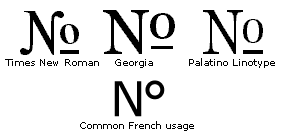Note
Access to this page requires authorization. You can try signing in or changing directories.
Access to this page requires authorization. You can try changing directories.
This section is in two parts. The first section is for symbol characters found in the Macintosh character set. The second section is for symbols found in many mathematics and symbol based PC code pages.
Spacing
All symbol characters are used with numerals or mathematical formulas and should space well between figure zeros.
Symbols for the Macintosh standard character set
Previous to TrueType fonts these symbols were only present in a PostScript symbol font in ROM on Macintosh printers and as screen bitmaps in the Macintosh font 'suitcase'. The characters from the regular weight Times Roman font were used for all fonts. As TrueType fonts were developed many font companies continued this practice and included only one design based on a Times family in all their fonts. PC font formats used a similar method of using a universal font for math symbols but expanded the selection of glyphs to include some sans serif and bold characters to better match the current font.
The following characters are part of the Macintosh Standard Character Set.
Product
Unicode: U+220FDesign : This character is similar in design to the uppercase Greek Pi U+03A0 with the exception of the overall vertical alignment.
Alignment : The bottom of the Product aligns with the Summation U+2211 that descends below the baseline commonly 1/2 to 3/4 of the lowercase descender. The top aligns with the uppercase flat height.
Advance width : The Advance width is proportional to the design.
Lowercase Greek pi
Unicode: U+03C0Design : The Macintosh Standard Character Set includes this character in the Macintosh 'cmap' table (platform ID 1 encoding ID 0 at position xB9). Some TrueType fonts that do not contain support for the Greek language have used the Unicode value in the private use area instead of the lowercase Greek pi Unicode value.
Advance width : The Advance width is the same as the Greek lowercase pi U+03C0 or proportional to the design.
Integral
Unicode: U+222BAdvance width : The Advance width is proportional to the design.
Alignment : Commonly the integral aligns to approximately the height of the lowercase ascender and descender.
Ohm
Unicode: U+2126Design : This character is commonly the same as the uppercase Greek Omega U+03A9.
Advance width : The Advance width is commonly the same as the uppercase Greek Omega U+03A9 or proportional to the design.
Increment
Unicode: U+2206Design : This character is the same design as the uppercase Greek Delta U+0394.
Advance width : The Advance width is commonly the same as the uppercase Greek Delta or proportional to the design.
Summation
Unicode: U+2211Design : This character is the similar in design to the uppercase Greek Sigma U+03A3 with the exception of the overall vertical alignment.
Alignment : The bottom of the summation aligns with the Product U+220F that descends below the baseline commonly 1/2 to 3/4 of the lowercase descender. The top aligns with the uppercase flat height.
Advance width : The Advance width is proportional to the design.
Lozenge
Unicode: U+25CADesign : This is an open diamond shaped character that is commonly three-quarters of the uppercase height with the strokes being monoline.
Advance width : The Advance width is proportional to the design.
Alignment : This symbol commonly sits on the baseline.
Additional symbols in PC code pages
Unicode characters U+2190 through U+266B
Characters in this range are commonly referred to as 'universal math and symbol characters'. Many of these characters in this range are resident in the original set of Microsoft Windows core fonts Times New Roman, Arial and Courier New and most printer resident font formats. In these Microsoft core fonts all symbols are designed specifically to match the style of the host font or typeface family.
Estimated
Unicode: U+212EDesign : This character could be considered a logotype. It is used in Europe for product packaging to show the estimated volume of the product. Its design is a standardised shape of a sans serif _lowercase e _with straight inner contours.

Alignment : This symbol varies in size but sits on the baseline in all designs.
Advance width : The Advance width is proportional to the design.
Single prime mark
Unicode: U+2032Double prime mark
Unicode: U+2033Prime and double prime marks, also called minute and second, are used in the abbreviations for inches, feet, minutes and seconds. The angle of these characters is commonly a slight italic angle of approximately 75..80 degrees on both roman and italic fonts. Perfectly vertical is considered 90 degrees. The single neutral quote U+0027 and double neutral quote U+0022 are often used as substitutes or equivalents for these two characters.
Advance width rule : The advance width of the single prime mark is proportional to the design and the double prime mark is commonly not greater than two times the advance width of the single prime mark.
Numero mark
Unicode: U+2116The numero mark resides in Unicode in the section 'Letterlike Symbols'. It is used in several languages as an abbreviation for the word number. It is a very commonly used abbreviation in the French language and it is almost always typed manually with either an uppercase N or lowercase n and a degree symbol.
Example: _the common French abbreviation for the word _Number would be N° and number would be n°.
The numero is also used in the Cyrillic code page 1251 for Microsoft Windows at position alt-0185 (xB9).
Advance width rule : The advance width of the numero is proportional to the design.
